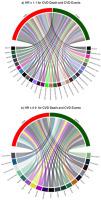当前位置:
X-MOL 学术
›
Anal. Chim. Acta
›
论文详情
Our official English website, www.x-mol.net, welcomes your
feedback! (Note: you will need to create a separate account there.)
Exploratory analysis of large-scale lipidome in large cohorts: are we any closer of finding lipid-based markers suitable for CVD risk stratification and management?
Analytica Chimica Acta ( IF 5.7 ) Pub Date : 2021-01-01 , DOI: 10.1016/j.aca.2020.10.037 Sílvia O. Diaz , José Luis Sánchez-Quesada , Victor de Freitas , Adelino Leite-Moreira , António S. Barros , Ana Reis
Analytica Chimica Acta ( IF 5.7 ) Pub Date : 2021-01-01 , DOI: 10.1016/j.aca.2020.10.037 Sílvia O. Diaz , José Luis Sánchez-Quesada , Victor de Freitas , Adelino Leite-Moreira , António S. Barros , Ana Reis

|
Cardiovascular diseases (CVD) remain the biggest cause of deaths worldwide and a major socio-economic impact to society. In this work, we conducted an unbiased exploratory analysis of the large-scale lipidome in human plasma samples from patients with fatal and non-fatal CVD from large cohorts. The exploratory analysis included data from 10,349 individuals from 20 countries in Asia, Australasia, Europe and North America (ADVANCE cohort), and thus representative of the worldwide population. Through the analysis of hazard ratios (HR), we found 306 lipids relevant in CV Death and 294 lipids relevant in CV Events of which 262 lipids were common to fatal and non-fatal events followed over time (3, 5 and 8 years). Our exploratory analysis reveals that, over time, the plasma lipid signature found in non-fatal CVD events is similar to that preceding CVD death. Among the common lipid signature, we found that sphingolipids (HexCer, SM, Cer and other glycosphingolipids) and phospholipids (PC and PE) were strongly associated with CVD events outcome, while polyunsaturated plasmenyl PC and PE lipids were inversely associated with CV outcome. The restricted panel of specific lipids has the potential to improve CVD risk stratification and management, and significantly reduce the time involved in the analysis and data treatment in low-resolution MS instruments making plasma lipidomics a cost-efficient approach for clinical scenario. In our view, once standardized clinical, analytical and data reporting guidelines are implemented worldwide, lipid-based discriminators can be routinely applied in the CVD risk stratification and improve the performance of current clinical, biochemical and imaging diagnostic tools assisting the decision-making process particularly in patients with multiple co-morbidities.
中文翻译:

大型队列中大规模脂质组的探索性分析:我们是否更接近于找到适合 CVD 风险分层和管理的基于脂质的标志物?
心血管疾病 (CVD) 仍然是全球最大的死亡原因,并对社会产生重大的社会经济影响。在这项工作中,我们对来自大型队列的致命和非致命 CVD 患者的人血浆样本中的大规模脂质组进行了公正的探索性分析。探索性分析包括来自亚洲、澳大拉西亚、欧洲和北美(ADVANCE 队列)20 个国家的 10,349 名个体的数据,因此代表了全球人口。通过风险比 (HR) 分析,我们发现 306 种脂质与 CV 死亡相关,294 种脂质与 CV 事件相关,其中 262 种脂质与随时间推移(3、5 和 8 年)的致命和非致命事件常见。我们的探索性分析表明,随着时间的推移,在非致命性 CVD 事件中发现的血脂特征与之前的 CVD 死亡相似。在常见的脂质特征中,我们发现鞘脂(HexCer、SM、Cer 和其他糖鞘脂)和磷脂(PC 和 PE)与 CVD 事件结果密切相关,而多不饱和纤溶酶 PC 和 PE 脂质与 CV 结果呈负相关。特定脂质的受限组有可能改善 CVD 风险分层和管理,并显着减少低分辨率 MS 仪器的分析和数据处理时间,使血浆脂质组学成为临床场景中具有成本效益的方法。我们认为,一旦标准化的临床、分析和数据报告指南在全球范围内实施,
更新日期:2021-01-01
中文翻译:

大型队列中大规模脂质组的探索性分析:我们是否更接近于找到适合 CVD 风险分层和管理的基于脂质的标志物?
心血管疾病 (CVD) 仍然是全球最大的死亡原因,并对社会产生重大的社会经济影响。在这项工作中,我们对来自大型队列的致命和非致命 CVD 患者的人血浆样本中的大规模脂质组进行了公正的探索性分析。探索性分析包括来自亚洲、澳大拉西亚、欧洲和北美(ADVANCE 队列)20 个国家的 10,349 名个体的数据,因此代表了全球人口。通过风险比 (HR) 分析,我们发现 306 种脂质与 CV 死亡相关,294 种脂质与 CV 事件相关,其中 262 种脂质与随时间推移(3、5 和 8 年)的致命和非致命事件常见。我们的探索性分析表明,随着时间的推移,在非致命性 CVD 事件中发现的血脂特征与之前的 CVD 死亡相似。在常见的脂质特征中,我们发现鞘脂(HexCer、SM、Cer 和其他糖鞘脂)和磷脂(PC 和 PE)与 CVD 事件结果密切相关,而多不饱和纤溶酶 PC 和 PE 脂质与 CV 结果呈负相关。特定脂质的受限组有可能改善 CVD 风险分层和管理,并显着减少低分辨率 MS 仪器的分析和数据处理时间,使血浆脂质组学成为临床场景中具有成本效益的方法。我们认为,一旦标准化的临床、分析和数据报告指南在全球范围内实施,











































 京公网安备 11010802027423号
京公网安备 11010802027423号